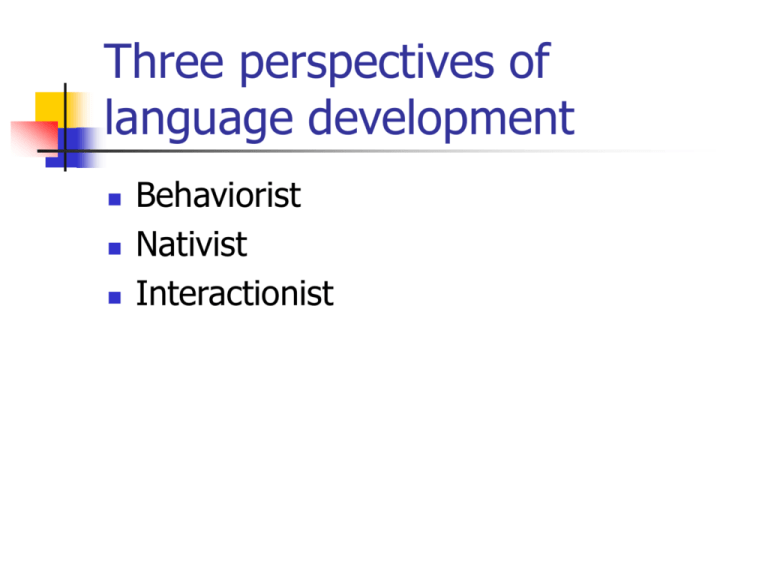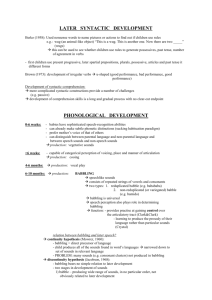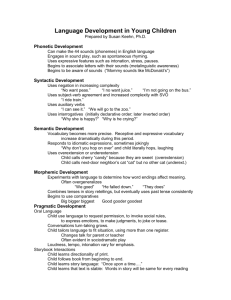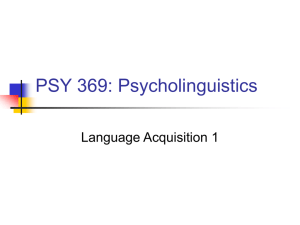Language Development: Theories and Stages
advertisement

Three perspectives of language development Behaviorist Nativist Interactionist Behaviorist perspective B.F. Skinner (1950s) Babbling that sounds like words is reinforced through operant conditioning; nonsense babbling is ignored by parents and is extinguished Imitation and reinforcement are keys to language development Wrong because most parents respond to ALL babbling Nativist perspective Noam Chomsky (1950s) Believed language was guided by an innate language acquisition device (LAD) that contains a set of rules common to all languages LAD tells babies what to look for in speech they hear Evidence: overregularizing verbs (age 3)— shows they’re making rule-based grammatical errors Problems with Nativist perspective What is the LAD exactly? Where is the LAD? Toddlers don’t really have a good understanding of grammatical rules, as Chomsky thought. They don’t acquire language as quickly as Chomsky thought. Progress is steady and gradual, not immediate. More learning and discovery involved than he thought. Interactionist perspective Combination of both theories Language involves some native capacity and some learning Rich linguistic environment is necessary for language to develop Don’t know how much is learned and how much is innate Getting ready to talk Cooing—begins at 2 months or so; baby makes pleasant vowel sounds Babbling—starts between 4-8 months; baby adds consonants (baba, dada) Deaf children don’t babble; babbling is dependent on hearing human speech. Babies start experimenting with real word sounds around first birthday Receptive language Ability to understand language 6 months of age—babies can discriminate among all sounds heard in all languages in the world, including sounds they don’t hear spoken to them. This ability fades by 12 months as they focus on native language sounds. By 9-10 months, babies understand 50 words; by 13 months, they understand 100. Expressive language The ability to talk First word is usually spoken around 12 months; doesn’t have to be a “real” word as long as baby uses it consistently to mean a specific thing First words Usually refer to important people, objects that move, or familiar actions Rarely name things that just sit there and don’t move or talk Children often refer to words by the sounds they make (dog = ruff ruff) 67% of words a 2-year-old speaks are nouns; 8.5% are verbs. Expressive vs. referential style Children with expressive style: first words are linked to social relationships instead of objects (yes, no, please, thank you, etc.) Referential style—first words are mostly names and pronouns; much more common than expressive style Holophrases One word combined with a gesture to indicate a two-word meaning Common at 12-18 months Common errors Overextension: child uses word too generally Underextension: child uses a general word to mean only one specific thing (cat = only the family cat); much less common than overextension Overextension reflects a child’s sensitivity to categories. May know the correct word but just be unable to say it, so they call it by the next closest word. Naming explosion and telegraphic speech Usually occurs around 16-24 months Vocabulary increases to around 300 words (from 50 words) Telegraphic speech: combining two words into a small, concise phrase. Occurs once baby has learned about 200 words. After telegraphic speech, children start adding more words to sentences, and they add emotional expression (18-24 months) Child-directed speech Form of language made up on short sentences with high-pitched, exaggerated expression and very clear pronunciation. Lots of repetition, simplified words, and questions. Parents naturally gravitate toward this way of speaking with toddlers. How to increase language development Respond to early coos and babbles with speech sounds READ often. This is the most important thing you can do! Ask questions about what they’re seeing and what you’re reading. Play social games like peek-a-boo, and play make-believe with your toddler. Ideally… A child should speak 1-5 words by 12 months and 50 words by age 2 If he’s not speaking at all by age 2, consider early intervention or speech therapy. Frequent ear infections in infancy/toddlerhood can delay speech production.










